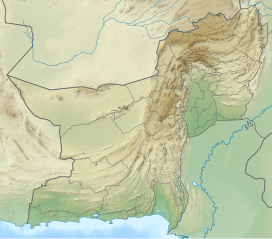Sulaiman Mountains
| Sulaiman Range | |
|---|---|
| د كسې غرونه / کوه سليمان | |
 Satellite image of a part of the Sulaiman Range | |
| Highest point | |
| Elevation | 3,487 m (11,440 ft) |
| Coordinates | 30°30′N 70°10′E / 30.500°N 70.167°E |
| Dimensions | |
| Area | 6,475 km2 (2,500 sq mi)https://dgkhan.punjab.gov.pk/tribal_area |
| Geography | |
| Location | Zabul, Kandahar and Loya Paktia, Afghanistan Balochistan, and Khyber Pakhtunkhwa, Pakistan |
| Parent range | Hindu Kush |
The Sulaiman Mountains, also known as Kōh-e Sulaymān (
The most well-known peak of the Sulaimans is the twin-peaked
Geography
The eastern edge of the Sulaiman range runs 280 miles (450 km) from the
In Afghanistan, the western edge of the range starts just beyond the northern
The Sulaiman Range, and the high plateaus to the west of it, helps form a natural barrier against the humid winds that blow from the
Rivers that drain the Sulaimans include the Gomal River which flows eastward into the Indus River, and the Dori River and other small tributaries of the Arghandab River, which flow southwestward into the Helmand River.[citation needed]
Geology
The Sulaimans were formed as a fold and thrust belt as the Indian Plate collided into Eurasian Plate beginning about 30 million years ago.[8] The Indian Plate's counter-clockwise rotation as it collided with the Eurasian Plate resulted in the Sulaiman's having some of the most complex tectonic structures in the world,[8] including "stacking" of thrust faults.[9] The complex fault-system is capable of producing doublet earthquakes that jump to other faults - such as the 1997 Harnai earthquake in which a magnitude 7.1 earthquake triggered a 6.8 earthquake 19 seconds later on a second fault 50 kilometres away.[10]
Areas in the southern part of the range include an Imbricate fan of slices of rocks in close parallel,[8] bounded by faults on either side of each slice.[11] Along the Eastern edge of the Sulaimans is the Sulaiman Fold, an area within the Indian Plate consisting of sediment, alongside which runs the Ornach Nal-Ghazaband-Chaman Fault.[12]
Legends about Takht-e-Sulaiman

One of the highest peaks of the Sulaimans, the
In legend, it is associated with Prophet Solomon. According to the legend, Prophet Solomon climbed this mountain and looked out over the land of South Asia, which was then covered with darkness, and so turned back without descending into this new frontier, and left only the mountain which is named after him (as told by Ibn Battuta).[14]
According to another legend,
Another legend says that Qais Abdur Rashid, said to be the legendary ancestor of the Pashtun nation, is buried atop Takht-e-Sulaiman, and so it is also locally known as Da Kasī Ghar (د کسي غر, "Mount of Qais").
According to this legend, his descendants migrated west, north, and south from here. Some people visit the place and make animal sacrifices, usually a sheep or a goat, at the tomb of Qais to help feed the poor.[citation needed] Trips to the mountain is undertaken mostly in summer, since from late November until March the snowfall makes it difficult to climb.[15]
See also
- Loe Nekan
- Wadani
- Spin Ghar
- Hindu Kush
- List of mountain ranges of the world
- Fort Munro
- Sheikh Badin
References
- ISBN 978-1-63355-947-9.
- ISBN 978-0-19-577411-5.
- ^ "Koh-e-Suleman | District Dera Ghazi Khan". dgkhan.punjab.gov.pk. Retrieved 2023-06-06.
- ^ "USGS Bulletin 2208-C: Sembar Goru/Ghazij Composite Total Petroleum System, Indus and Sulaiman-Kirthar Geologic Provinces, Pakistan and India". pubs.usgs.gov. Retrieved 2020-04-20.
- ISBN 978-1-78046-579-1.
- ^ Shah, Syed Ali (10 July 2013). "In Balochistan, an ancient forest battles for survival". Dawn. Retrieved 28 December 2014.
- ^ "Sulaiman Range | mountains, Pakistan". Encyclopedia Britannica. Retrieved 2020-08-16.
- ^ a b c "Forging Sulaiman Range". earthobservatory.nasa.gov. 2014-07-23. Retrieved 2020-08-16.
- ^ Maldonado, Florian (2011). "Summary of the Stratigraphy and Structural Elements Related to Plate Convergence of the Quetta-Muslim Bagh-Sibi Region, Balochistan, West-Central Pakistan" (PDF). USGS. Reston, Virginia: U.S. Geological Survey.
- ^ "Earthquakes can jump long distances". EARTH Magazine. 2016-06-29. Retrieved 2020-08-16.
- ^ "Science Source - Imbricate Fan, Sulaiman Range, Pakistan". www.sciencesource.com. Retrieved 2020-08-16.
- ISBN 978-1-78046-579-1.
- ^ "NASA Earth Observatory - Newsroom". Earthobservatory.nasa.gov. 6 February 2019. Retrieved 6 February 2019.
- ISBN 9780330418799.
- ^ "Shariat and Tasawwuf". Books.themajlis.net. Retrieved 6 February 2019.


